Ever wondered how to bring the exquisite flavors of Japan into your kitchen? Whether you’re craving a quick weeknight dinner or planning a special meal, our roundup of 18 delicious Japanese fish recipes has something for every occasion. From crispy tempura to comforting miso-glazed salmon, these dishes are sure to delight your taste buds and inspire your next culinary adventure. Dive in and discover your new favorite recipe today!
Grilled Salmon Teriyaki

Deliciously simple and packed with flavor, this Grilled Salmon Teriyaki is your next go-to for a quick yet impressive meal. You’ll love how the sweet and savory glaze caramelizes on the grill, giving the salmon a perfect char.
Ingredients
- 4 salmon fillets (about 6 oz each, skin-on for extra flavor)
- 1/2 cup teriyaki sauce (homemade or store-bought, for convenience)
- 1 tbsp olive oil (or any neutral oil, to prevent sticking)
- 1 tsp garlic powder (adjust to taste, for that extra kick)
- 1 tbsp brown sugar (optional, for a sweeter glaze)
Instructions
- Preheat your grill to medium-high heat, about 375°F, ensuring it’s clean and lightly oiled to prevent sticking.
- In a small bowl, mix the teriyaki sauce with garlic powder and brown sugar (if using) until well combined.
- Brush both sides of the salmon fillets with olive oil, then generously coat with the teriyaki mixture.
- Place the salmon skin-side down on the grill. Close the lid and cook for 4-5 minutes, allowing the glaze to caramelize.
- Carefully flip the salmon using a spatula. Grill for another 3-4 minutes, or until the fish flakes easily with a fork.
- Remove from grill and let rest for 2 minutes before serving to allow the juices to redistribute.
Kick back and enjoy the perfectly balanced flavors of this Grilled Salmon Teriyaki. The crispy skin and tender, flaky meat pair wonderfully with a side of steamed rice or a fresh salad for a complete meal.
Japanese-Style Mackerel Sushi
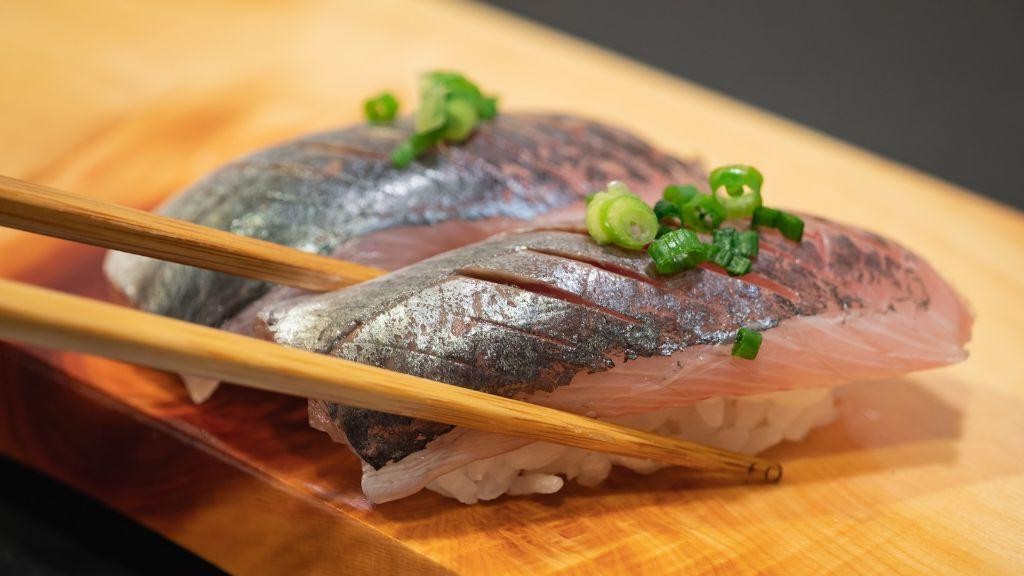
Ready to dive into the world of homemade sushi with a twist? Japanese-Style Mackerel Sushi is your ticket to impressing your friends or treating yourself to something special. It’s simpler than you think, and the flavors are out of this world.
Ingredients
- 1 cup sushi rice (short-grain works best)
- 1 1/4 cups water (for perfectly cooked rice)
- 2 tbsp rice vinegar (adds that signature tang)
- 1 tbsp sugar (balances the vinegar’s acidity)
- 1/2 tsp salt (enhances all the flavors)
- 4 oz fresh mackerel fillet (look for shiny, firm flesh)
- 1 tbsp soy sauce (or tamari for gluten-free)
- 1 tsp wasabi (adjust to your heat preference)
- 1/2 avocado, sliced (adds creaminess)
- 1 sheet nori (for that classic sushi look)
Instructions
- Rinse the sushi rice under cold water until the water runs clear, about 3-4 times. This removes excess starch for the perfect texture.
- Combine the rinsed rice and water in a rice cooker. Cook on the sushi setting, or follow your rice cooker’s instructions for white rice. Tip: Let the rice sit for 10 minutes after cooking for the best consistency.
- While the rice cooks, mix the rice vinegar, sugar, and salt in a small bowl until dissolved. Gently fold this into the cooked rice with a wooden spoon. Tip: Fan the rice while mixing to help it cool and get glossy.
- Slice the mackerel into thin strips, about 1/4 inch thick. Tip: A sharp knife dipped in water makes cleaner cuts.
- Lay a nori sheet on a bamboo mat. Spread a thin layer of rice over the nori, leaving a 1-inch border at the top.
- Arrange the mackerel and avocado slices in a line along the bottom edge of the rice. Roll tightly using the bamboo mat, pressing gently as you go.
- Slice the roll into 6-8 pieces with a wet knife for clean edges. Serve with soy sauce and wasabi on the side.
Craving something that’s both rich and refreshing? The mackerel’s bold flavor pairs beautifully with the creamy avocado, while the sushi rice ties it all together with a slight sweetness. Try serving these rolls with a side of pickled ginger for an extra zing.
Pan-Seared Tuna with Wasabi Sauce
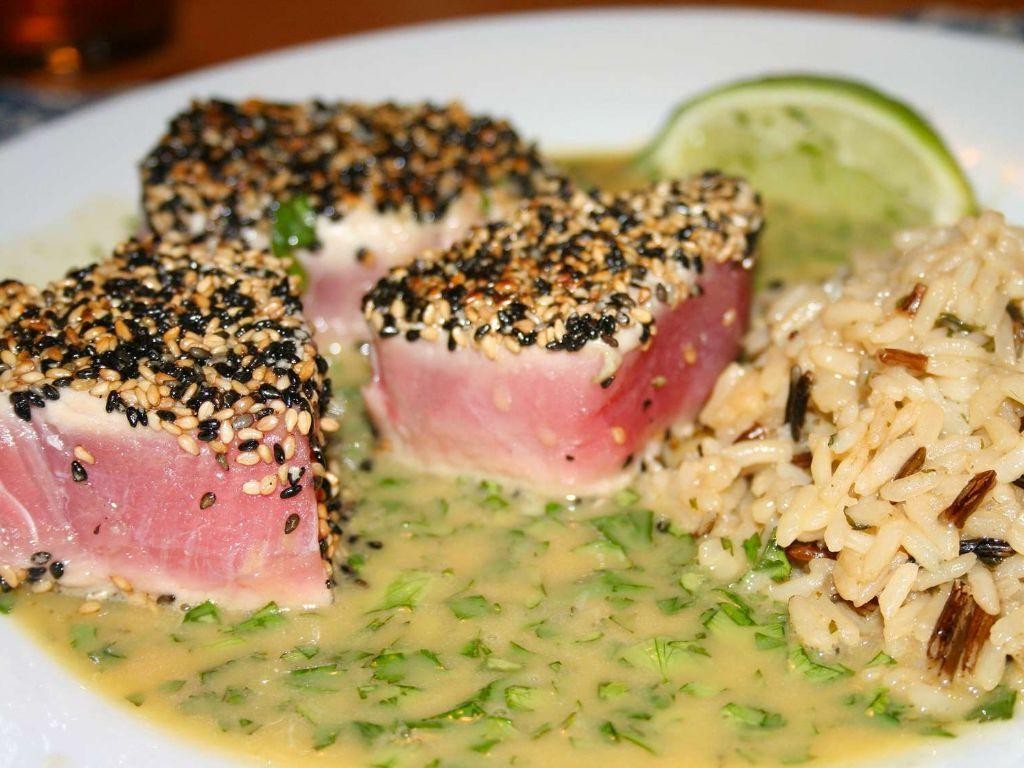
You’ve probably had tuna a dozen ways, but pan-seared with a kicky wasabi sauce? That’s a game-changer. It’s quick, packed with flavor, and feels fancy without the fuss.
Ingredients
- 2 tuna steaks (about 1 inch thick, for even cooking)
- 1 tbsp olive oil (or any neutral oil)
- 1/2 tsp salt (adjust to taste)
- 1/4 tsp black pepper (freshly ground preferred)
- 2 tbsp soy sauce (low sodium works too)
- 1 tbsp wasabi paste (adjust to taste for heat)
- 1 tsp honey (for a touch of sweetness)
- 1 tbsp water (to thin the sauce if needed)
Instructions
- Pat the tuna steaks dry with paper towels. This helps get a good sear.
- Heat olive oil in a skillet over medium-high heat until shimmering, about 2 minutes.
- Season tuna steaks with salt and pepper on both sides.
- Place tuna in the skillet. Cook for 1-2 minutes per side for medium-rare, or until desired doneness. Tip: Don’t move the tuna once it’s in the pan to ensure a nice crust.
- While tuna cooks, whisk together soy sauce, wasabi paste, honey, and water in a small bowl. Tip: Start with less wasabi and add more to suit your heat preference.
- Remove tuna from skillet and let rest for 1 minute before slicing. Tip: Letting it rest keeps it juicy.
- Drizzle wasabi sauce over the tuna or serve on the side for dipping.
Now, the tuna should be perfectly seared on the outside, tender and pink inside, with that wasabi sauce adding a creamy, spicy punch. Try serving it over a crisp salad or with steamed rice to soak up all that delicious sauce.
Japanese Fish Curry
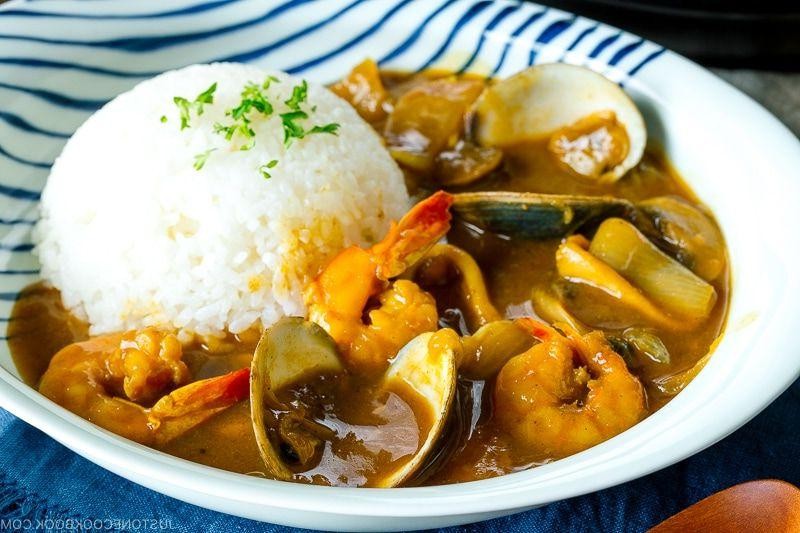
Alright, you’re in for a treat with this Japanese Fish Curry recipe. It’s a comforting, flavorful dish that’s surprisingly easy to whip up, perfect for those nights when you’re craving something a bit different.
Ingredients
- 1 lb white fish fillets (like cod or halibut, cut into chunks)
- 2 tbsp vegetable oil (or any neutral oil)
- 1 onion, thinly sliced
- 2 carrots, cut into bite-sized pieces
- 2 potatoes, peeled and cut into bite-sized pieces
- 3 cups water
- 1 package Japanese curry roux (about 3.5 oz, adjust to taste)
- 1 tbsp soy sauce (optional, for extra umami)
Instructions
- Heat the oil in a large pot over medium heat. Add the onion and sauté until translucent, about 5 minutes.
- Add the carrots and potatoes to the pot. Cook for another 5 minutes, stirring occasionally.
- Pour in the water and bring to a boil. Reduce heat to low, cover, and simmer for 10 minutes, or until the vegetables are tender.
- Add the fish chunks and curry roux to the pot. Stir gently to dissolve the roux without breaking the fish.
- Simmer uncovered for another 5 minutes, or until the fish is cooked through and the curry has thickened. Tip: If the curry is too thick, add a little more water.
- Stir in the soy sauce if using. Taste and adjust the seasoning if necessary.
Light, flaky fish in a rich, savory curry sauce makes this dish a winner. Serve it over steamed rice for the ultimate comfort meal, or try it with udon noodles for a twist.
Steamed Sea Bass with Ginger and Scallions
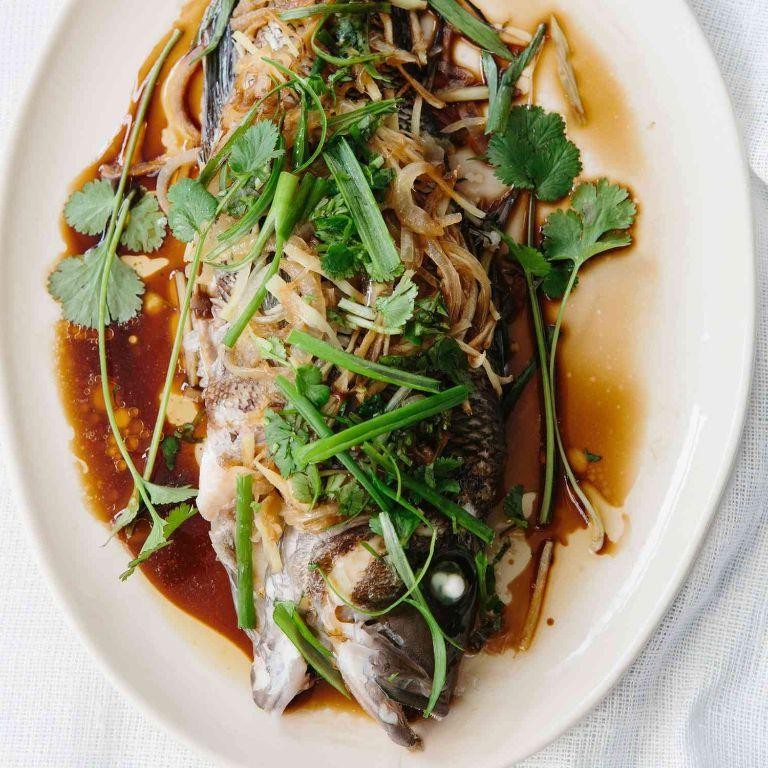
Alright, let’s dive into making a dish that’s as light and refreshing as a summer breeze—steamed sea bass with ginger and scallions. It’s simple, flavorful, and perfect for when you want something healthy without sacrificing taste.
Ingredients
- 1 whole sea bass (about 1.5 lbs), cleaned and scaled
- 2 tbsp soy sauce (or tamari for gluten-free)
- 1 tbsp sesame oil
- 1 inch ginger, julienned (more if you love ginger)
- 2 scallions, cut into 2-inch strips
- 1 tbsp vegetable oil (or any neutral oil)
- 1/2 cup water (for steaming)
Instructions
- Rinse the sea bass under cold water and pat dry with paper towels. This ensures the skin steams nicely without excess moisture.
- Make 3 diagonal cuts on each side of the fish. This helps the heat penetrate evenly and the flavors to seep in.
- Place the fish on a heatproof plate that fits inside your steamer. Scatter the ginger and half of the scallions over and inside the fish.
- Fill a wok or pot with the water and bring to a boil over high heat. Once boiling, place the plate with the fish in the steamer, cover, and steam for 10-12 minutes. The fish is done when the flesh flakes easily with a fork.
- While the fish is steaming, heat the vegetable oil in a small pan until shimmering. This will be used to add a final aromatic touch.
- Once the fish is cooked, carefully remove the plate from the steamer. Pour the soy sauce and sesame oil over the fish, then top with the remaining scallions.
- Immediately drizzle the hot oil over the scallions to release their fragrance. Be cautious as the oil may splatter.
Light and flaky, the sea bass melts in your mouth with the zing of ginger and the freshness of scallions. Serve it over a bed of jasmine rice to soak up all the delicious sauces, or alongside some stir-fried greens for a complete meal.
Tempura Fried Fish
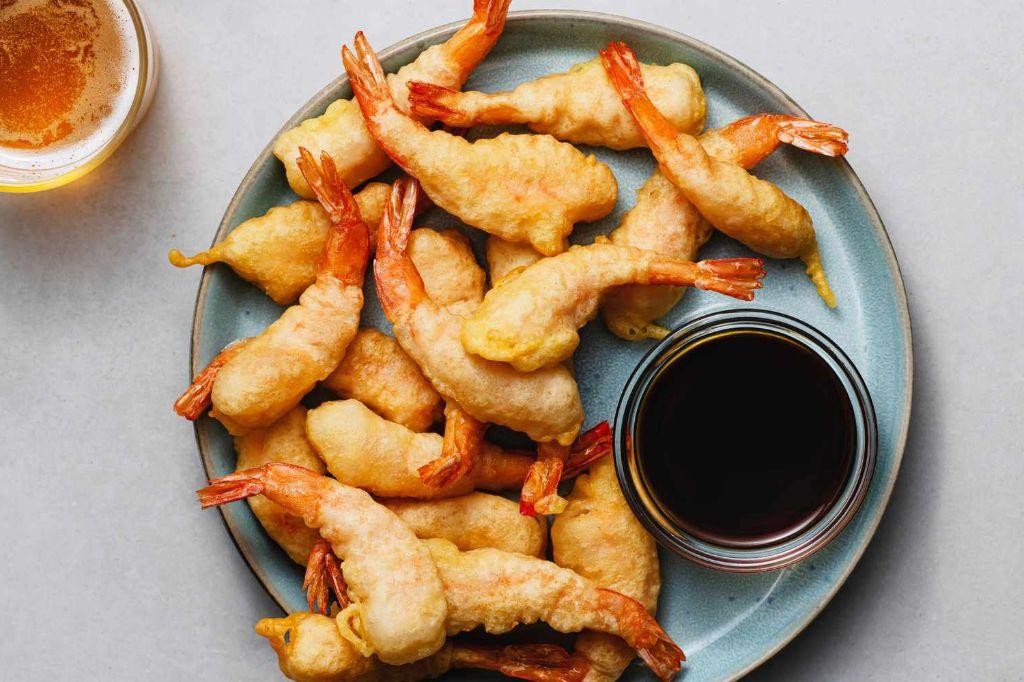
Feeling like mixing up your dinner routine? Tempura fried fish is your ticket to a crispy, light meal that’s surprisingly easy to whip up at home.
Ingredients
- 1 cup all-purpose flour (for a lighter batter, try cake flour)
- 1 egg, cold (helps keep the batter light)
- 1 cup ice-cold water (the colder, the crispier the tempura)
- 1 lb white fish fillets (cod or halibut work great), cut into strips
- 2 cups vegetable oil (or any neutral oil for frying)
- 1 tsp salt (adjust to taste)
Instructions
- In a large bowl, whisk the egg lightly, then gradually mix in the ice-cold water to avoid clumping.
- Sift the flour and salt into the egg mixture, stirring just until combined—lumps are okay and actually help keep the batter light.
- Heat the oil in a deep fryer or large pot to 350°F, using a thermometer to ensure accuracy for the perfect crisp.
- Dip each fish strip into the batter, letting excess drip off, then carefully lower into the hot oil. Don’t overcrowd the pot to maintain oil temperature.
- Fry for about 2-3 minutes until golden and crispy, turning once for even cooking. Drain on a wire rack to keep them crisp.
The result? A beautifully golden, crispy exterior giving way to tender, flaky fish inside. Serve with a side of tangy dipping sauce or atop a bowl of steamed rice for a meal that’s sure to impress.
Japanese Fish Cake (Kamaboko)
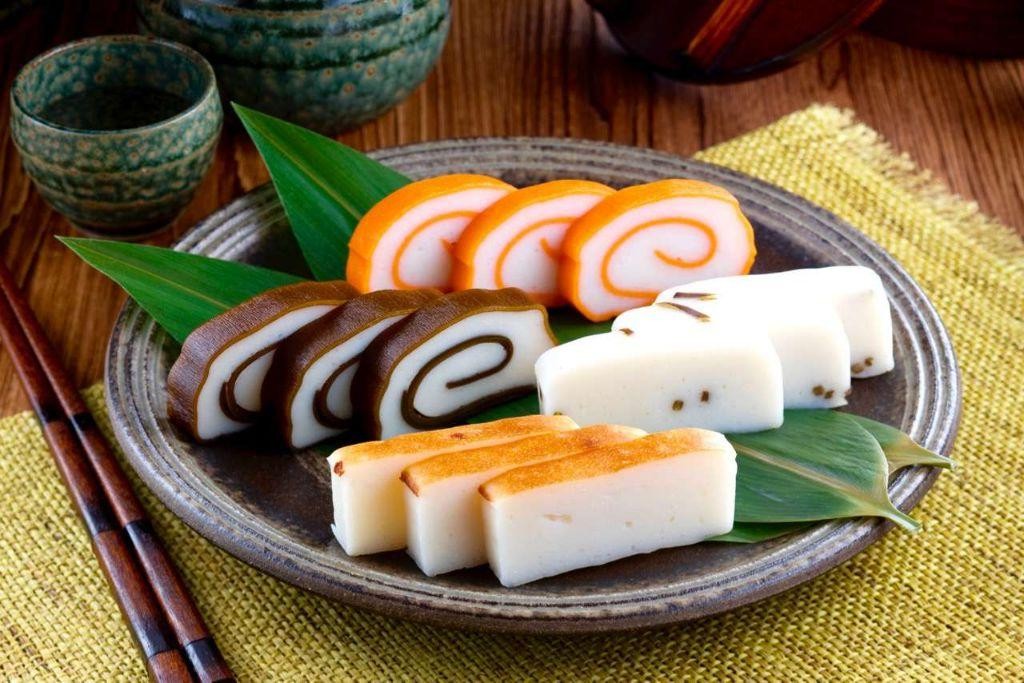
Oh, you’re in for a treat with this Japanese Fish Cake, or Kamaboko. It’s a delightful, bouncy seafood delight that’s as fun to make as it is to eat, perfect for adding a touch of Japan to your table.
Ingredients
- 1 lb white fish fillet (like cod or pollock), finely minced
- 1 tsp salt (adjust to taste)
- 1 tbsp sugar
- 1 egg white
- 1 tbsp cornstarch (for binding)
- 1/2 cup ice water (to keep the mixture cold)
Instructions
- In a food processor, blend the minced fish fillet until it becomes a smooth paste.
- Add salt, sugar, egg white, and cornstarch to the fish paste. Blend again until well combined.
- Gradually add ice water to the mixture while blending, to keep it cold and ensure a smooth texture.
- Once the mixture is sticky and elastic, shape it into a log on a piece of plastic wrap.
- Steam the fish cake log over boiling water for 15 minutes, or until firm to the touch.
- Let it cool before slicing thinly to serve.
Kamaboko has a uniquely springy texture and a mild, sweet fish flavor that pairs wonderfully with soy sauce or in soups. Try it atop a bowl of ramen for an authentic touch.
Sashimi Platter with Various Fish
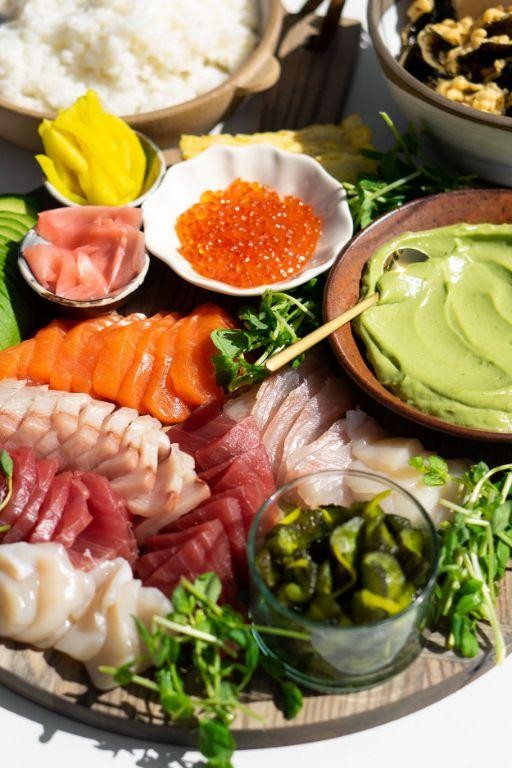
Got a craving for something fresh and light? A sashimi platter with various fish is your go-to for a quick, elegant meal that’s all about the quality of the ingredients. You’ll love how simple it is to put together, yet it feels like a special treat every time.
Ingredients
- 1 lb assorted sashimi-grade fish (like tuna, salmon, and yellowtail) – ask your fishmonger for the freshest cuts
- 1/4 cup soy sauce – or tamari for a gluten-free option
- 2 tbsp wasabi paste – adjust to your heat preference
- 1/4 cup pickled ginger – for a refreshing palate cleanser
- 1/2 cup daikon radish, thinly sliced – adds a crisp texture
Instructions
- Start by placing your sashimi-grade fish in the freezer for about 20 minutes. This makes it easier to slice thinly.
- While the fish is chilling, prepare your serving platter. Arrange the daikon radish slices as a bed for the sashimi.
- Remove the fish from the freezer. Using a sharp knife, slice the fish against the grain into 1/4-inch thick pieces. Tip: A sharper knife gives cleaner cuts.
- Arrange the sliced fish on top of the daikon radish. Overlapping the slices slightly adds visual appeal.
- Place small bowls of soy sauce and wasabi paste on the side. Tip: Mix a little wasabi into the soy sauce for a unified flavor.
- Garnish the platter with pickled ginger. Tip: Serve immediately to enjoy the fish at its freshest.
Kick back and enjoy the melt-in-your-mouth texture of the sashimi, paired with the sharpness of the wasabi and the sweetness of the ginger. For a fun twist, try serving with a side of sushi rice or avocado slices for a more filling meal.
Grilled Yellowtail with Miso
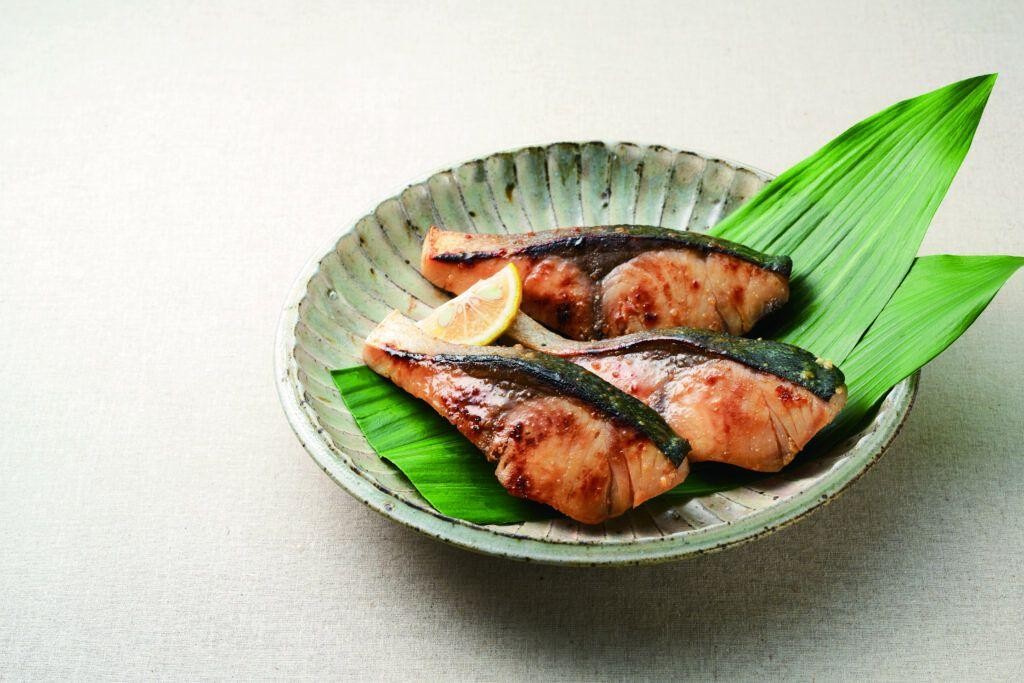
Venturing into the world of Japanese cuisine at home? Grilled Yellowtail with Miso is a stellar dish to start with—it’s simple, flavorful, and feels like a treat. You’ll love how the miso caramelizes under the broiler, giving the fish a sweet and savory crust.
Ingredients
- 4 yellowtail fillets (about 6 oz each), skin on
- 1/2 cup white miso paste (look for ‘shiro miso’ for a milder flavor)
- 2 tbsp mirin (or substitute with a mix of 1 tbsp sugar and 1 tbsp water)
- 1 tbsp sake (optional, but adds depth)
- 1 tbsp sugar (adjust to taste)
- 1 tsp grated ginger (fresh is best, but bottled works in a pinch)
Instructions
- In a small bowl, whisk together the miso paste, mirin, sake, sugar, and grated ginger until smooth. This is your marinade.
- Pat the yellowtail fillets dry with paper towels. This helps the marinade stick better.
- Spread the marinade evenly over the flesh side of each fillet. Let them sit at room temperature for 15 minutes to marinate.
- Preheat your broiler on high and position the oven rack 6 inches from the heat source.
- Place the fillets on a broiler pan, skin side down. Broil for 7-10 minutes, watching closely, until the marinade is bubbly and slightly charred at the edges.
- Remove from the oven and let rest for 2 minutes before serving. This allows the juices to redistribute.
Out of the oven, the yellowtail should be flaky yet moist, with a rich, umami-packed crust from the miso. Serve it over steamed rice with a side of pickled vegetables for a complete meal that’s sure to impress.
Japanese Fish Stew (Nabe)
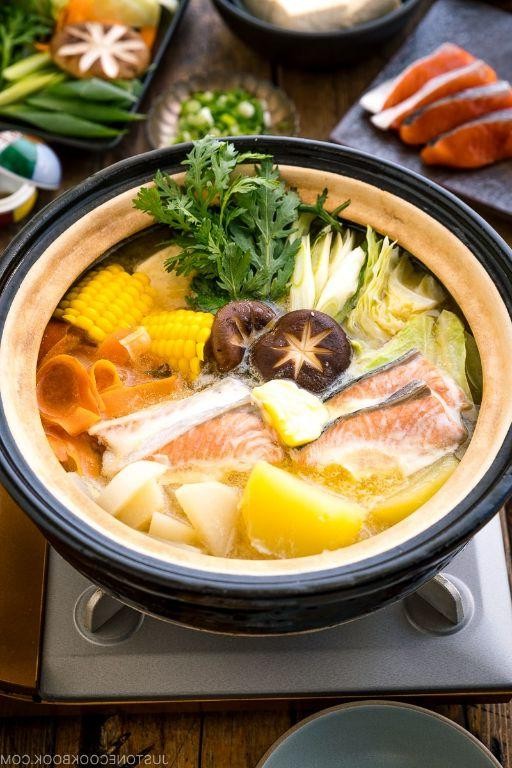
So, you’re looking to cozy up with a bowl of something warm and comforting? Japanese Fish Stew, or Nabe, is your go-to. It’s a simple, flavorful dish that brings the family together around the table.
Ingredients
- 1 lb white fish fillets (like cod or halibut, cut into chunks)
- 4 cups dashi stock (homemade or instant, for authentic flavor)
- 1 tbsp soy sauce (adjust to taste)
- 1 tbsp mirin (or a pinch of sugar as substitute)
- 1 cup napa cabbage (chopped, or any leafy greens you have)
- 1 carrot (sliced thin, for quick cooking)
- 2 green onions (cut into 2-inch pieces, for a mild bite)
- 1 tsp ginger (grated, for a hint of spice)
Instructions
- In a large pot, bring the dashi stock to a gentle simmer over medium heat.
- Add the soy sauce and mirin to the pot, stirring lightly to combine.
- Layer the napa cabbage and carrot slices at the bottom of the pot, letting them soften for about 5 minutes.
- Gently place the fish chunks on top of the vegetables, ensuring they’re submerged in the broth.
- Scatter the green onions and grated ginger over the fish.
- Cover the pot and let everything cook together for 10 minutes, or until the fish is opaque and flakes easily.
- Tip: Don’t stir the pot too much to keep the fish intact. Serve directly from the pot for a communal dining experience.
Rich in umami and lightly sweet from the mirin, this stew is a hug in a bowl. Try serving it with a side of steamed rice to soak up all the delicious broth.
Fried Fish Karaage
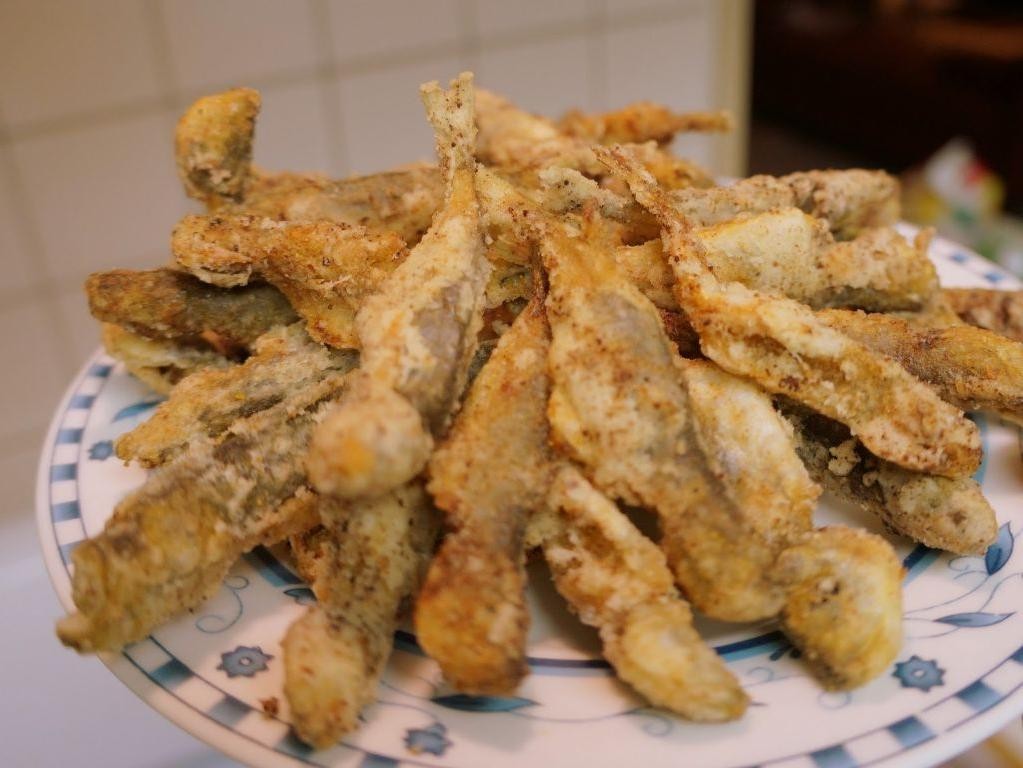
Mmm, there’s nothing quite like the crispy, juicy delight of Fried Fish Karaage. You’re going to love how simple it is to whip up this Japanese favorite at home, perfect for those nights when you’re craving something fried but want to keep it light.
Ingredients
- 1 lb white fish fillets, cut into bite-sized pieces (cod or tilapia works great)
- 1 cup potato starch (for that extra crispiness, or cornstarch as a substitute)
- 1 tbsp soy sauce (adjust to taste)
- 1 tbsp sake (or mirin for a sweeter touch)
- 1 tsp ginger, grated (fresh is best)
- 1 tsp garlic, minced
- Oil for frying (vegetable or canola oil recommended)
Instructions
- In a bowl, mix the fish pieces with soy sauce, sake, ginger, and garlic. Let it marinate for 15 minutes in the fridge.
- Heat oil in a deep fryer or large pot to 350°F. Use a thermometer to ensure accuracy.
- Drain the fish from the marinade and toss each piece in potato starch until fully coated. Shake off excess.
- Fry the fish in batches for about 3-4 minutes, or until golden brown and crispy. Don’t overcrowd the pot.
- Remove with a slotted spoon and drain on paper towels. Serve immediately for the best texture.
Golden and crispy on the outside, tender and flaky on the inside, this Fried Fish Karaage is a game-changer. Try serving it with a squeeze of lemon or a side of tartar sauce for an extra zing.
Salmon Onigiri with Fish Flakes
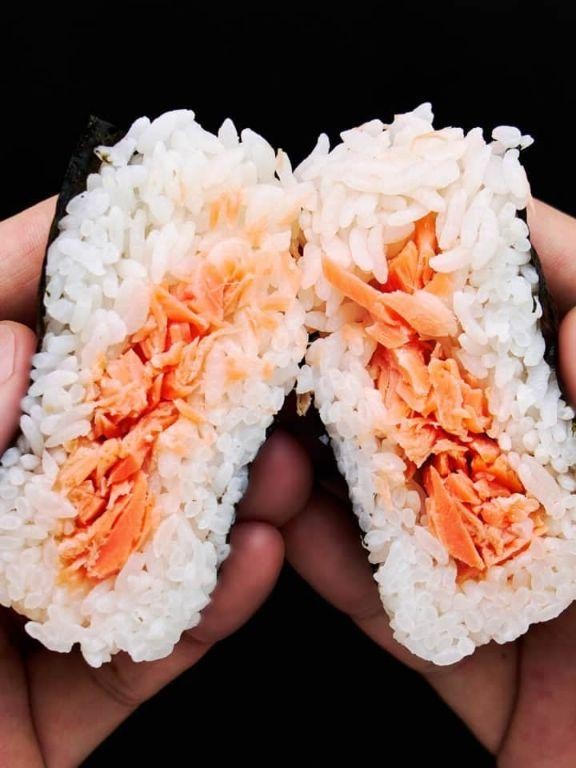
Did you know that making Salmon Onigiri with Fish Flakes is easier than you think? Perfect for a quick snack or a lunchbox treat, these rice balls are packed with flavor and fun to make.
Ingredients
- 2 cups sushi rice (short-grain works best)
- 1/2 lb fresh salmon, skin removed (or use pre-cooked for convenience)
- 1 tbsp soy sauce (low sodium if preferred)
- 1 tsp sesame oil (toasted for extra flavor)
- 1/4 cup fish flakes (bonito flakes are a great choice)
- 1 sheet nori, cut into strips (for wrapping or garnish)
- Salt to taste (start with a pinch)
Instructions
- Rinse the sushi rice under cold water until the water runs clear, then cook according to package instructions. Let it cool slightly.
- While the rice cooks, season the salmon with soy sauce and sesame oil. Pan-fry over medium heat for 3-4 minutes per side, or until fully cooked. Let it cool, then flake into small pieces.
- Mix the flaked salmon and fish flakes into the warm rice. Add a pinch of salt if needed.
- Wet your hands to prevent sticking, then shape the rice mixture into triangles or balls. Press firmly so they hold their shape.
- Wrap each onigiri with a strip of nori, or sprinkle extra fish flakes on top for garnish.
These Salmon Onigiri are wonderfully savory with a hint of smokiness from the fish flakes. Try serving them with a side of pickled ginger for a tangy contrast, or pack them for a picnic—they’re just as good at room temperature.
Japanese-Style Fish and Chips

Ready to shake up your fish and chips game? This Japanese-style version brings a crispy, umami-packed twist to the classic, perfect for when you’re craving something familiar yet exciting.
Ingredients
- 1 lb cod fillets, cut into strips (or any firm white fish)
- 1 cup all-purpose flour (for a lighter batter, substitute with 1/2 cup flour and 1/2 cup cornstarch)
- 1 cup panko breadcrumbs (for extra crunch)
- 1 egg, beaten (helps the coating stick)
- 1 cup cold sparkling water (the secret to a light batter)
- 1 tsp salt (adjust to taste)
- 1/2 tsp black pepper (freshly ground for best flavor)
- Vegetable oil for frying (or any neutral oil, enough for 2 inches in a deep pan)
- 1 lemon, cut into wedges (for serving)
- 1 tbsp nori flakes (optional, for a seaweed flavor boost)
Instructions
- In a large bowl, mix flour, salt, and pepper. Gradually whisk in sparkling water until the batter is smooth. Tip: The batter should coat the back of a spoon but drip off slowly.
- Heat oil in a deep pan to 350°F. Use a thermometer to ensure accuracy for the crispiest results.
- Dip each fish strip into the beaten egg, then coat in panko breadcrumbs. For extra crunch, press the panko gently onto the fish.
- Dip the breaded fish into the batter, letting excess drip off, then carefully lower into the hot oil. Fry in batches to avoid overcrowding.
- Fry for 3-4 minutes until golden brown and crispy. Tip: Flip halfway through for even cooking.
- Remove with a slotted spoon and drain on paper towels. Sprinkle with nori flakes while hot if using.
The texture is a delightful contrast of crispy outside and tender inside, with a subtle umami kick from the nori. Try serving with a side of wasabi mayo for an extra flavor punch.
Simmered Fish in Soy Sauce (Nitsuke)
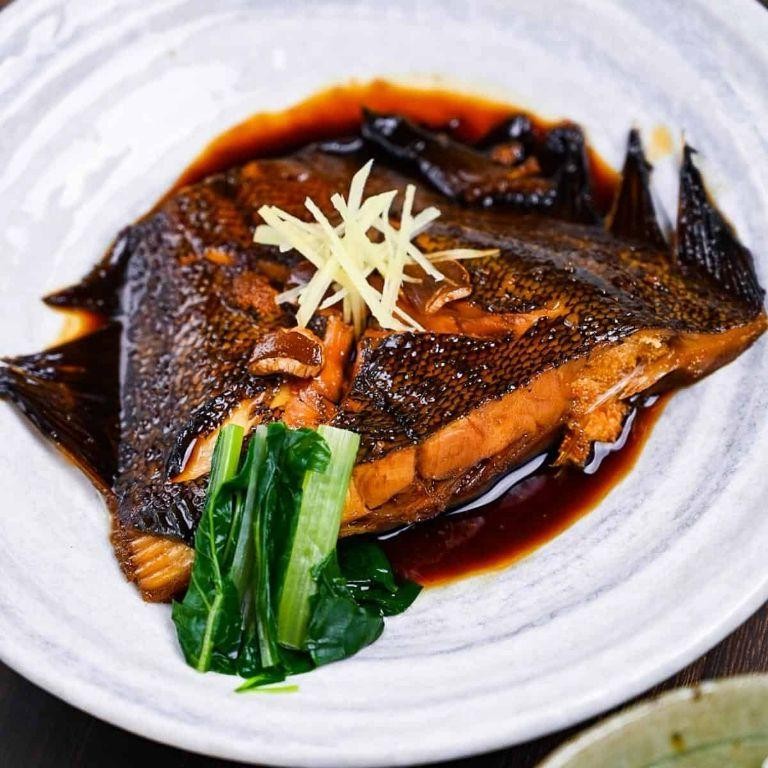
Believe it or not, this Simmered Fish in Soy Sauce (Nitsuke) is a game-changer for weeknight dinners. It’s simple, flavorful, and feels like a hug in a bowl.
Ingredients
- 1 lb white fish fillets (like cod or halibut, skin-on for extra flavor)
- 1/2 cup soy sauce (low-sodium works too)
- 1/4 cup mirin (or a mix of 2 tbsp sugar and 2 tbsp water)
- 1/4 cup sake (or dry white wine)
- 1 tbsp sugar (adjust to taste)
- 1 inch ginger, sliced (peel it for a milder flavor)
- 2 green onions, cut into 2-inch pieces (save some for garnish)
Instructions
- Pat the fish fillets dry with paper towels to ensure they brown nicely.
- In a medium saucepan, combine soy sauce, mirin, sake, sugar, ginger, and green onions. Bring to a simmer over medium heat, stirring until the sugar dissolves.
- Gently add the fish fillets to the saucepan, skin side up. Reduce heat to low, cover, and simmer for 10 minutes. Tip: Don’t stir the fish; let it cook undisturbed to keep it intact.
- After 10 minutes, carefully flip the fillets and simmer for another 5 minutes, uncovered. Tip: The sauce should thicken slightly; if it’s too thin, simmer a bit longer.
- Remove from heat and let the fish sit in the sauce for 5 minutes to absorb more flavor. Tip: This resting time makes a big difference in taste.
Unbelievably tender, the fish flakes apart with a fork, soaked in a sweet-salty sauce that’s downright addictive. Serve it over steamed rice with a sprinkle of green onions for a meal that’ll have everyone asking for seconds.
Fish Donburi (Rice Bowl)

This Fish Donburi is your ticket to a quick, satisfying meal that feels like a hug in a bowl. Think tender fish over fluffy rice, with a drizzle of sauce that ties it all together.
Ingredients
- 1 cup sushi rice (or any short-grain rice for stickiness)
- 1 1/4 cups water (for cooking rice)
- 2 fillets of white fish (like cod or tilapia, about 6 oz each)
- 1 tbsp soy sauce (or tamari for gluten-free)
- 1 tbsp mirin (adds a sweet depth)
- 1 tsp sugar (balances the sauce)
- 1/2 tsp grated ginger (fresh is best)
- 1 green onion, thinly sliced (for garnish)
- 1 tbsp vegetable oil (or any neutral oil)
Instructions
- Rinse the sushi rice under cold water until the water runs clear, then drain.
- Combine the rice and water in a rice cooker or pot. Cook according to your rice cooker’s instructions or bring to a boil, then simmer covered for 18 minutes. Let it sit for 5 minutes off the heat.
- While the rice cooks, mix soy sauce, mirin, sugar, and grated ginger in a small bowl to make the sauce.
- Heat oil in a pan over medium-high. Pat the fish fillets dry and cook for 3-4 minutes per side, until golden and flakes easily.
- Pour the sauce over the fish in the last minute of cooking, letting it bubble and thicken slightly.
- Fluff the rice with a fork and divide between two bowls. Top with the fish and drizzle any remaining sauce from the pan.
- Garnish with sliced green onions.
Just like that, you’ve got a bowl with the perfect mix of savory, sweet, and umami. The rice soaks up the sauce beautifully, making every bite a delight. Try adding a sprinkle of sesame seeds or a side of pickled ginger for extra zing.
Japanese Fish Soup (Ushiojiru)
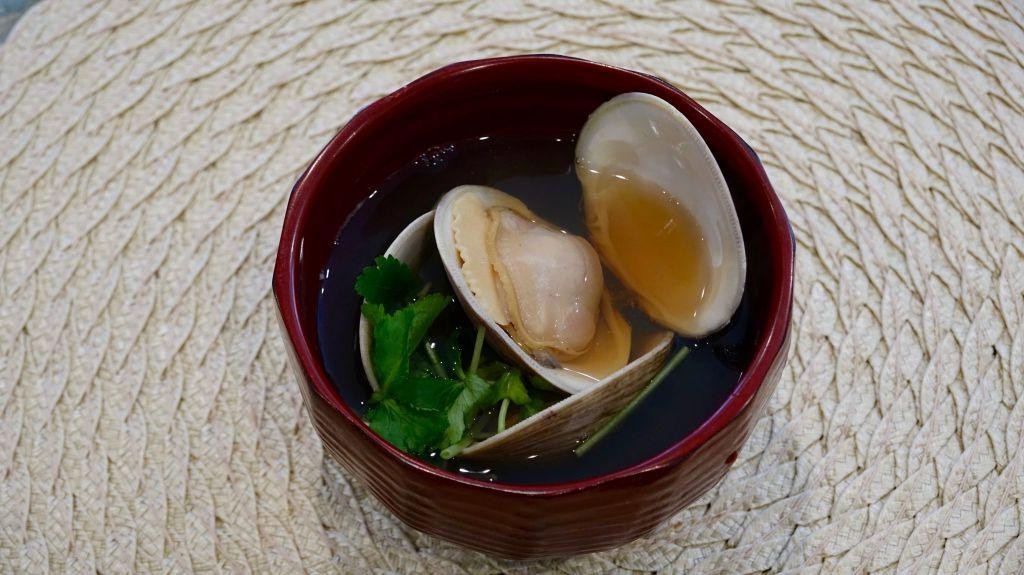
Just imagine a bowl of light, flavorful broth with tender pieces of fish—that’s Ushiojiru for you. It’s a simple yet elegant Japanese fish soup that brings the ocean’s freshness right to your table.
Ingredients
- 4 cups dashi stock (homemade or instant, for authentic flavor)
- 1 lb white fish fillets (like cod or snapper, cut into bite-sized pieces)
- 1 tbsp sake (optional, adds depth)
- 1 tsp salt (adjust to taste)
- 1/2 tsp soy sauce (for a hint of umami)
- 2 green onions (thinly sliced, for garnish)
- 1 tsp grated ginger (for a fresh kick)
Instructions
- Heat the dashi stock in a medium pot over medium heat until it just begins to simmer, about 5 minutes.
- Add the fish pieces to the pot gently, ensuring they’re submerged in the stock.
- Pour in the sake, if using, and let the soup simmer for another 3 minutes—fish should be just cooked through.
- Season with salt and soy sauce, stirring lightly to combine without breaking the fish.
- Remove the pot from heat and divide the soup among bowls.
- Garnish each bowl with green onions and a pinch of grated ginger right before serving.
You’ll love the delicate balance of flavors in this soup—the dashi’s umami, the fish’s sweetness, and the ginger’s zing. Try serving it with a side of steamed rice for a comforting meal.
Grilled Sardines with Salt (Shioyaki)
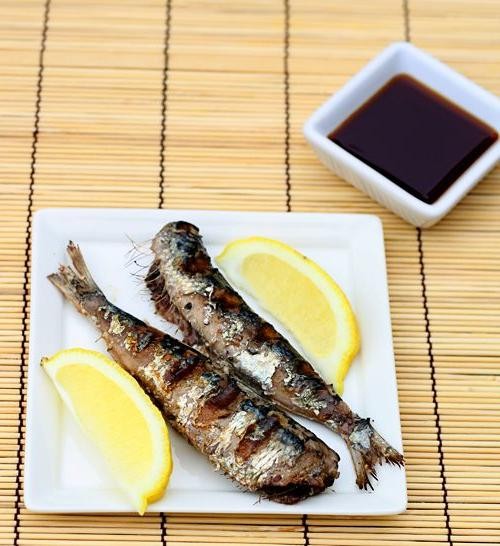
So, you’re looking to spice up your grilling game with something simple yet utterly delicious? Grilled sardines with salt, or Shioyaki, is your go-to. It’s a no-fuss dish that packs a punch of flavor, perfect for those summer evenings when you want something light yet satisfying.
Ingredients
- 4 fresh sardines, cleaned and gutted (ask your fishmonger to do this for you)
- 1 tbsp sea salt (adjust based on the size of your sardines)
- 1 tbsp vegetable oil (or any neutral oil for greasing)
Instructions
- Preheat your grill to medium-high heat, about 400°F. This ensures a nice sear without burning.
- While the grill heats up, pat the sardines dry with paper towels. Moisture is the enemy of a good sear.
- Lightly brush both sides of each sardine with vegetable oil. This helps prevent sticking and promotes even cooking.
- Sprinkle sea salt evenly over both sides of the sardines. Don’t be shy; the salt forms a delicious crust.
- Place the sardines on the grill. Cook for about 3-4 minutes on each side. Look for crispy skin and opaque flesh before flipping.
- Once done, remove from the grill and let them rest for a minute. This keeps them juicy.
Grilled sardines with salt are all about that crispy skin and tender, flaky inside. Serve them with a squeeze of lemon or over a bed of greens for a light meal that feels anything but.
Japanese Fish Pie with Miso
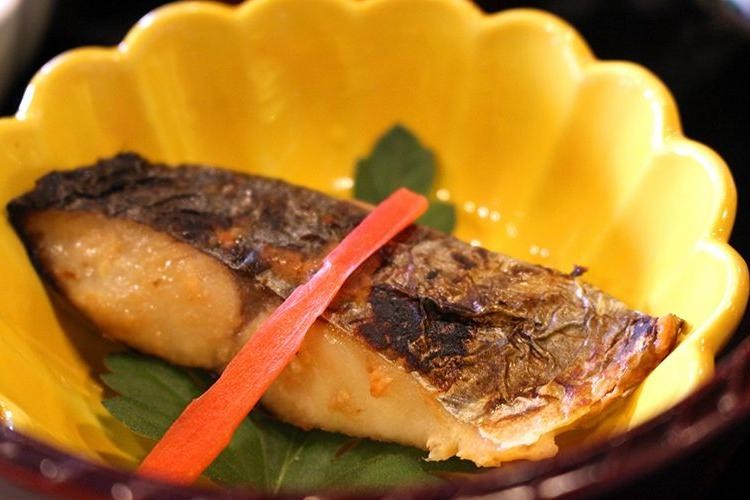
Zesty and comforting, this Japanese Fish Pie with Miso is a twist on the classic that’ll have you coming back for seconds. It’s creamy, umami-packed, and surprisingly easy to whip up.
Ingredients
- 1 lb white fish fillets, cut into chunks (cod or haddock works great)
- 1 cup whole milk (for extra creaminess, or sub with half-and-half)
- 2 tbsp white miso paste (adjust to taste)
- 1 tbsp unsalted butter (or any neutral oil)
- 1/2 cup frozen peas (no need to thaw)
- 1 sheet puff pastry, thawed (keep it cold until ready to use)
- 1 egg, beaten (for egg wash)
Instructions
- Preheat your oven to 400°F (200°C). This ensures a crispy pastry top.
- In a saucepan, gently heat the milk over medium heat until warm but not boiling. Stir in the miso paste until fully dissolved. Tip: Avoid boiling to keep the miso’s flavor intact.
- Add the fish chunks to the milk mixture, simmering for 5 minutes until just cooked. The fish should flake easily with a fork.
- Stir in the frozen peas and butter, then remove from heat. The residual heat will cook the peas perfectly.
- Transfer the fish mixture to a pie dish. Cover with the puff pastry, trimming any excess. Seal the edges by pressing down with a fork.
- Brush the pastry with beaten egg for a golden finish. Make a few slits on top to let steam escape.
- Bake for 25-30 minutes until the pastry is puffed and golden. Tip: Rotate the dish halfway for even browning.
Mmm, the pie comes out with a flaky crust and a creamy, savory filling that’s just divine. Serve it with a side of pickled ginger for an extra zing.
Conclusion
Absolutely, this roundup of 18 Delicious Japanese Fish Recipes offers something for every occasion, from weeknight dinners to special gatherings. We hope these dishes inspire you to explore the rich flavors of Japanese cuisine. Don’t forget to try them out, leave a comment with your favorite, and share the love by pinning this article on Pinterest. Happy cooking!


